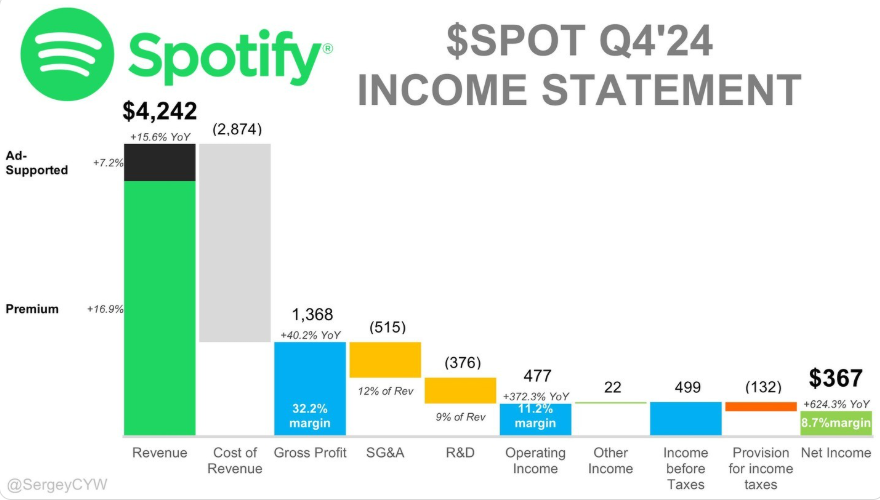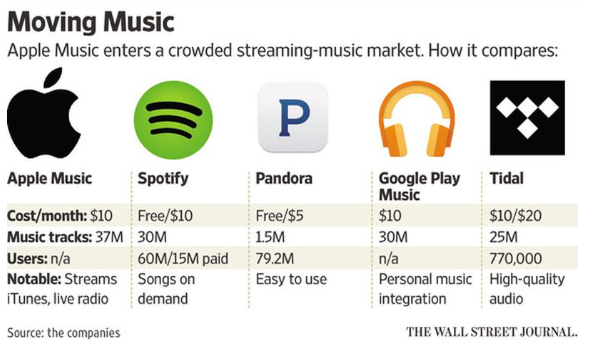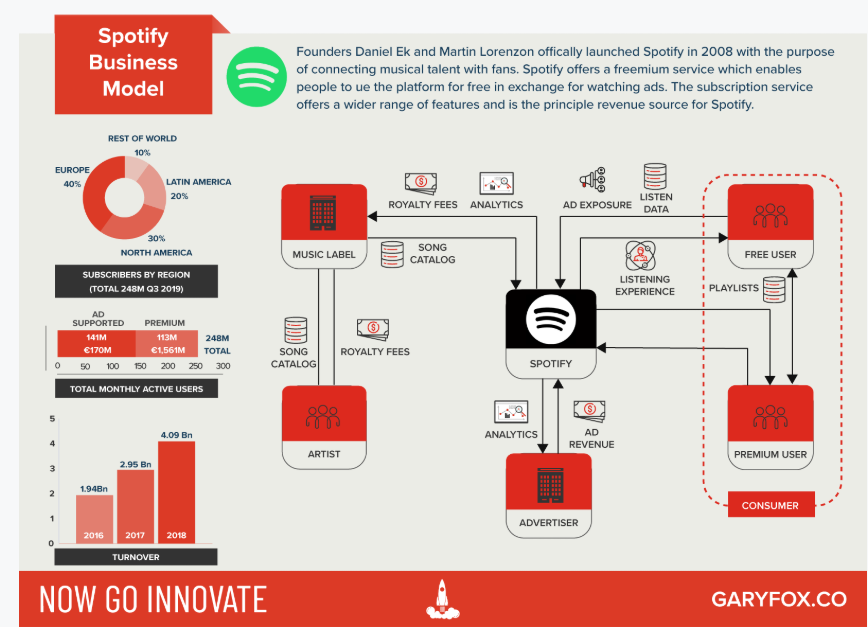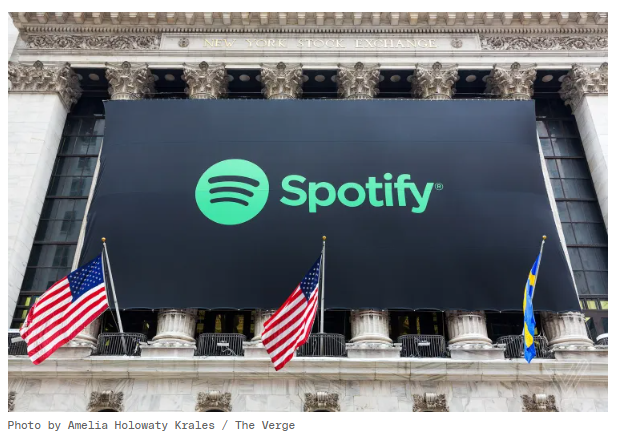Spotify investment analysis shows how the world’s largest music streaming service provider is navigating growth and profitability challenges, dominating the audio streaming market with over 640 million monthly active users (MAUs) as of Q4 2024. As Spotify continues to expand beyond music into podcasts, audiobooks, and other audio content, investors are keen to understand whether the stock remains a smart investment in 2025.
📈 Spotify Investment Analysis: Financial Performance and Profitability

This Spotify investment analysis delves into the company’s strategic growth and profitability outlook.
Q4 2024 Earnings – A Turnaround to Profitability
Spotify recently reported impressive earnings for Q4 2024, marking a significant turnaround to profitability. The company’s financial highlights include:
- Revenue: €4.24 billion (up 15.6% YoY)
- Earnings Per Share (EPS): €1.76
- Annual EPS (2024): €5.50
- Free Cash Flow (FCF): €2.3 billion (record high)
- Gross Margin: 27.2%
💡 Key Takeaway:
Spotify has achieved consistent revenue growth and positive cash flow, which are critical factors for long-term financial stability. The transition from loss to profitability demonstrates that the company’s growth strategy is starting to pay off.
(Source: Investors.com)
📊 Stock Performance and Market Sentiment
Current Stock Price and Trend
As of March 2025, Spotify’s stock price is approximately $490.69, reflecting a strong upward trend from its 52-week low of $272.50. Despite recent market volatility, the stock has shown resilience, largely driven by positive earnings reports and strategic expansions.
💹 Market Sentiment:
- Bullish: Analysts from Morgan Stanley and Goldman Sachs have raised their price targets to $530 and $550 respectively.
- Bearish: Some experts caution against Spotify’s high valuation, with a P/E ratio of 89.2, making it susceptible to corrections if growth slows.
(Source: NASDAQ)
🔑 Investment Thesis – Why Spotify Remains a Strong Bet

1. Dominant Market Position
Spotify is the undisputed leader in music streaming, holding a 31% market share globally. It has outpaced competitors like Apple Music, Amazon Music, and YouTube Music due to its robust content library and superior user experience.
2. Revenue Diversification
Spotify’s strategy to move beyond music into podcasts, audiobooks, and video content is a game-changer. By acquiring companies like Megaphone and Anchor, it has significantly strengthened its podcasting ecosystem.
Premium and Ad-Supported Models
- Premium Subscribers: 252 million (up 6 million YoY)
- Ad-Supported Users: 388 million (up 14 million YoY)
- Revenue Split:
- Premium Subscriptions: 84% of revenue
- Ad-Supported Revenue: 16% of revenue
💡 Key Takeaway:
By broadening its revenue streams, Spotify mitigates risks associated with subscription fatigue and attracts new ad revenue, making its business model more sustainable.
🚀 Growth Catalysts to Watch

1. Podcast Monetization and Audiobook Expansion
Spotify’s push into podcasting has been a strategic masterstroke. The platform now hosts over 5 million podcasts, including exclusive content from major creators.
- Ad Revenue Growth: Expected to grow at a CAGR of 20% over the next three years.
- Audiobook Integration: Recently launched in multiple countries, adding another revenue stream.
2. Strategic Acquisitions and Partnerships
Spotify continues to acquire and partner with leading audio technology firms to enhance its platform. Notably:
- Findaway (Audiobook Distribution): Boosts audiobook offerings.
- Podz (Podcast Discovery): Improves user engagement through better content discovery.
- Exclusive Content Deals: Partnerships with creators like Joe Rogan and Alex Cooper help attract and retain subscribers.
🛑 Investment Risks to Consider

Investors looking at Spotify investment analysis should consider the long-term impact of rising content costs.
1. Profitability Concerns
Spotify’s path to profitability is still under scrutiny. Despite recent earnings improvements, licensing and royalty costs remain significant, pressuring margins.
- Operating Expenses: Increased due to content acquisition and platform development.
- Gross Margin: Although improving, it is still lower than competitors like Apple Music.
2. Competition Intensification
One of the critical aspects of Spotify investment analysis is understanding the competitive landscape.
Major competitors are doubling down on their streaming efforts:
- Apple Music: Integrates seamlessly with Apple devices.
- Amazon Music: Offers bundled services with Amazon Prime.
- YouTube Music: Free ad-supported model attracts budget-conscious users.
💡 Key Takeaway:
Spotify needs to sustain high user growth and increase ad revenue to remain competitive, especially as rivals continue to invest heavily in their platforms.
💼 Expert Opinions and Ratings
🔥 Bullish Perspective:
- Morgan Stanley: Target Price $530 – “Spotify’s content strategy and profitability gains make it a strong buy.”
- Goldman Sachs: Target Price $550 – “Ad revenue and podcast monetization are major growth drivers.”
🌧️ Bearish Perspective:
- JP Morgan: Target Price $450 – “High licensing costs and competitive pressures make the stock overvalued.”
- Barclays: Target Price $460 – “Profitability remains uncertain despite strong user metrics.”
💡 Final Verdict – Is Spotify Still Worth the Investment?
Spotify has demonstrated that it can achieve profitability while maintaining rapid user growth and revenue diversification. The strategic focus on podcasts and audiobooks is promising, but high licensing costs and fierce competition pose risks.
💪 Investment Strategy:
- Buy on Dips: Accumulate shares when market sentiment dips, as long-term growth prospects remain strong.
- Focus on Profitability Trends: Monitor quarterly earnings for consistent profitability and margin improvements.



